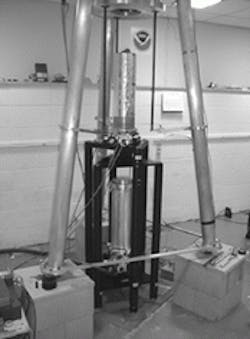
By measuring the gradient of the Earth's gravity field at points near or below ground level, geologists can pinpoint local density variations in the Earth's material that lead to knowledge about the movement of oil, water, and magma. Such information aids not only science, but oil exploration and production as well.
Absolute gravimeters, which operate by interferometrically tracking the descent of a falling reflective test body in a vacuum chamber, have existed for 30 years; first developed by Jim Faller at the Joint Institute for Laboratory Astrophysics (Boulder, CO), such instruments can determine the strength of a gravity field to an absolute accuracy of 1 µGal (a Gal—named after Galileo Galilei—is equal to 1 cm/s2). However, because absolute gravimeters measure at only one point, they cannot determine the field's gradient.
Device setup
Using fiberoptics to optically link two or more such gravimeters together, scientists at the University of Calgary (Calgary, Alberta, Canada), the Colorado School of Mines (Golden, CO), Micro-g Solutions (Erie, CO), and EM-g Inc. (Denver, CO) have developed an interferometric absolute differential gravimeter (ADG) that can potentially sense both the magnitude and direction of a gravity gradient. In the device's basic dual-sensor form, light from a single unstabilized 35-mW helium-neon laser is coupled into a single-mode fiber, then split by a 2 x 2 fiberoptic coupler and sent through two separate optical fibers. Each fiber serves as the light source for a separate interferometric gravimeter chamber within which a retroreflector is dropped and tracked. The return signals, which consist of fringe counts, are recombined in the original fiberoptic coupler. This creates a differential signal, which is then sent to a detector.
The two retroreflectors are dropped at slightly different times, producing a return signal at an easily measured frequency that shifts in the presence of a gravity gradient. The resulting gradient measurement and the distance between the two chambers determine the magnitude of the field gradient. Getting the direction of the gradient as well requires a setup containing a 2 x 4 fiberoptic coupler and four orthogonally placed chambers, enough to provide information for a gradient vector.
Because the fringe modulation received by the detector is a difference between fringe counts that stem from the same laser source, no precise clock or expensive stabilized laser is required. Although four coupled chambers are required to measure gradient direction, adding more chambers can provide details on the structure of the gravity field.
The ADG can potentially handle up to 50 coupled chambers, according to John Brown, a research scientist at Micro-g Solutions. By carefully timing the dropping of the sensors' retroreflectors, all differential fringe modulations can be separated in frequency to allow their independent measurement, with most of the frequency content falling in the 200-kHz range.
A prototype ADG contains two chambers placed vertically 91 cm apart (see photo on p. 22). In one test against a precise independent measure, the ADG produced a difference value of 290 ±8 µGal, which compared well to the independent 293.8 ±1.5 µGal value. Drop time for the retroreflectors is 200 ms; their travel height is 19 cm. The researchers are building a symmetric rise-and-fall chamber that will reduce travel height to 5 cm while maintaining a 250-ms travel time. Total cycle time of the measurements will eventually shrink to 500 ms. Experiments show that thermal or vibration-induced phase variations in the optical fibers are small enough to have little effect on measurements.
Possible applications
Of the many possible applications of the ADG, "it is oil production that we are most interested in," says Brown. He notes that injecting water into an older oilfield can help to flush the remaining oil out, but evaluating the success of this practice is tricky. Monitoring gravity gradient at many points throughout the field in real time would help engineers determine where, when, and how well the injection process is working. For adequate scope, an array of chambers may be placed in boreholes up to hundreds of meters apart.
Other potential uses of the instrument include monitoring of water tables, tracking magma in volcanoes, and mapping gravity gradients by air or boat for oil exploration. The prototype ADG is currently being incorporated into an experiment that is intended to pin down a more-precise value for G, the universal gravitational constant.
About the Author
John Wallace
Senior Technical Editor (1998-2022)
John Wallace was with Laser Focus World for nearly 25 years, retiring in late June 2022. He obtained a bachelor's degree in mechanical engineering and physics at Rutgers University and a master's in optical engineering at the University of Rochester. Before becoming an editor, John worked as an engineer at RCA, Exxon, Eastman Kodak, and GCA Corporation.
